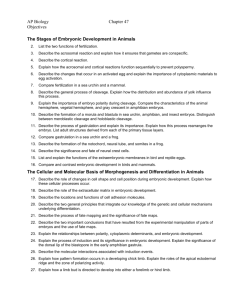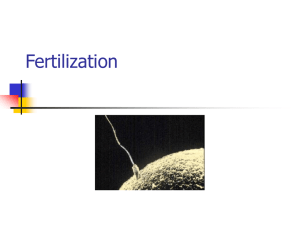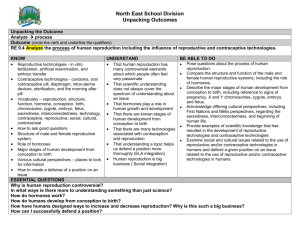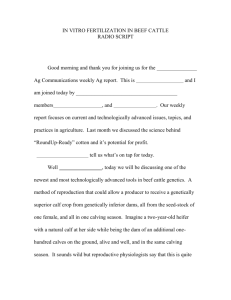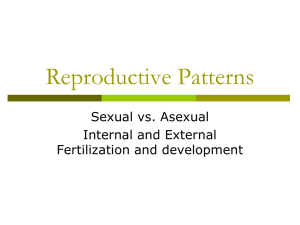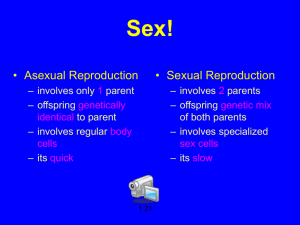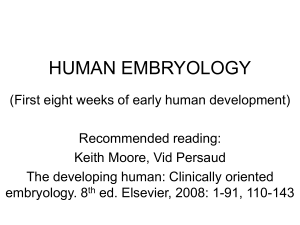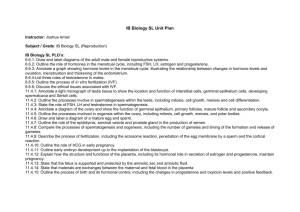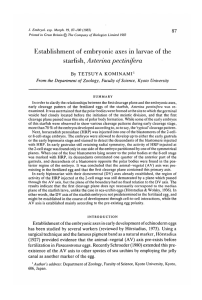Animal Reproduction, Development, and Behavior--
advertisement
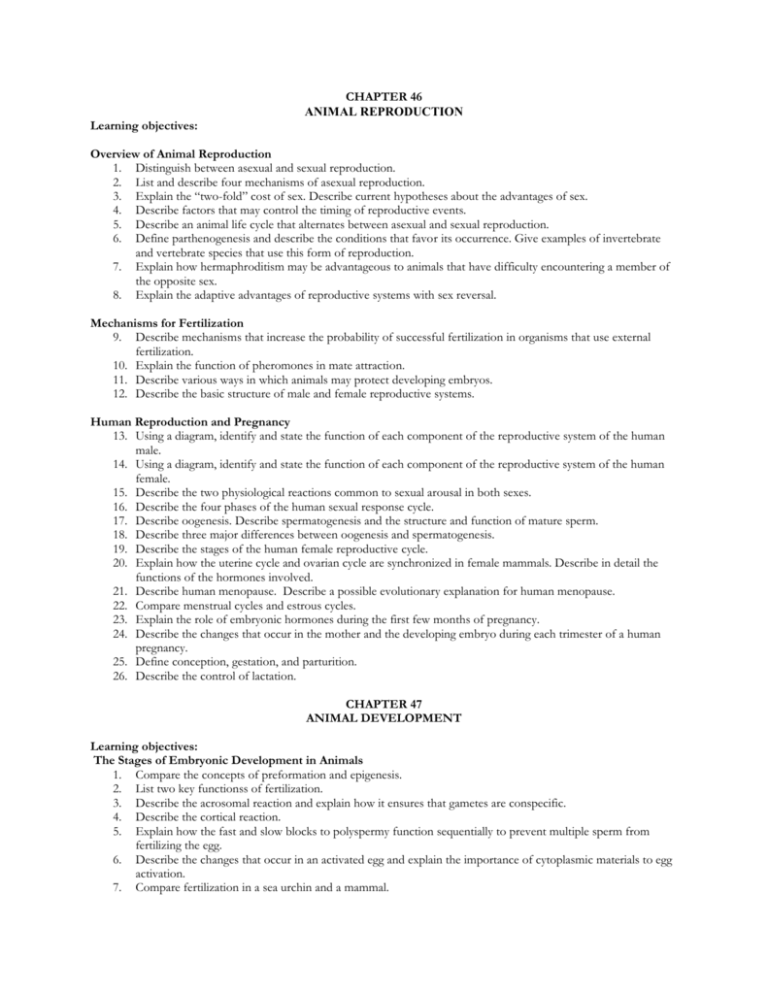
CHAPTER 46 ANIMAL REPRODUCTION Learning objectives: Overview of Animal Reproduction 1. Distinguish between asexual and sexual reproduction. 2. List and describe four mechanisms of asexual reproduction. 3. Explain the “two-fold” cost of sex. Describe current hypotheses about the advantages of sex. 4. Describe factors that may control the timing of reproductive events. 5. Describe an animal life cycle that alternates between asexual and sexual reproduction. 6. Define parthenogenesis and describe the conditions that favor its occurrence. Give examples of invertebrate and vertebrate species that use this form of reproduction. 7. Explain how hermaphroditism may be advantageous to animals that have difficulty encountering a member of the opposite sex. 8. Explain the adaptive advantages of reproductive systems with sex reversal. Mechanisms for Fertilization 9. Describe mechanisms that increase the probability of successful fertilization in organisms that use external fertilization. 10. Explain the function of pheromones in mate attraction. 11. Describe various ways in which animals may protect developing embryos. 12. Describe the basic structure of male and female reproductive systems. Human Reproduction and Pregnancy 13. Using a diagram, identify and state the function of each component of the reproductive system of the human male. 14. Using a diagram, identify and state the function of each component of the reproductive system of the human female. 15. Describe the two physiological reactions common to sexual arousal in both sexes. 16. Describe the four phases of the human sexual response cycle. 17. Describe oogenesis. Describe spermatogenesis and the structure and function of mature sperm. 18. Describe three major differences between oogenesis and spermatogenesis. 19. Describe the stages of the human female reproductive cycle. 20. Explain how the uterine cycle and ovarian cycle are synchronized in female mammals. Describe in detail the functions of the hormones involved. 21. Describe human menopause. Describe a possible evolutionary explanation for human menopause. 22. Compare menstrual cycles and estrous cycles. 23. Explain the role of embryonic hormones during the first few months of pregnancy. 24. Describe the changes that occur in the mother and the developing embryo during each trimester of a human pregnancy. 25. Define conception, gestation, and parturition. 26. Describe the control of lactation. CHAPTER 47 ANIMAL DEVELOPMENT Learning objectives: The Stages of Embryonic Development in Animals 1. Compare the concepts of preformation and epigenesis. 2. List two key functionss of fertilization. 3. Describe the acrosomal reaction and explain how it ensures that gametes are conspecific. 4. Describe the cortical reaction. 5. Explain how the fast and slow blocks to polyspermy function sequentially to prevent multiple sperm from fertilizing the egg. 6. Describe the changes that occur in an activated egg and explain the importance of cytoplasmic materials to egg activation. 7. Compare fertilization in a sea urchin and a mammal. 8. 9. 10. 11. 12. 13. 14. 15. 16. 17. 18. 19. Describe the general process of cleavage. Explain the importance of embryo polarity during cleavage. Compare the characteristics of the animal hemisphere, vegetal hemisphere, and gray crescent in amphibian embryos. Describe the formation of a blastula in sea urchin, amphibian, and bird embryos. Distinguish among meroblastic cleavage, holoblastic cleavage, and the formation of the blastoderm. Describe the product of cleavage in an insect embryo. Describe the process of gastrulation and explain its importance. Explain how this process rearranges the embryo. List adult structures derived from each of the primary germ layers. Compare gastrulation in a sea urchin, a frog, and a chick. Describe the formation of the notochord, neural tube, and somites in a frog. Describe the significance and fate of neural crest cells. Explain why neural crest cells have been called a “fourth germ layer”. List and explain the functions of the extraembryonic membranes in reptile eggs. Describe the events of cleavage in a mammalian embryo. Explain the significance of the inner cell mass. Explain the role of the trophoblast in implantation of a human embryo. Explain the functions of the extraembryonic membranes in mammalian development. The Cellular and Molecular Basis of Morphogenesis and Differentiation in Animals 20. Describe the significance of changes in cell shape and cell position during embryonic development. Describe the role of the cytoskeleton in these cellular processes. 21. Describe the process of convergent extension. 22. Describe the locations and functions of cell adhesion molecules. 23. Describe the role of the extracellular matrix in embryonic development. 24. Describe the two general principles that integrate our knowledge of the genetic and cellular mechanisms underlying differentiation. 25. Describe the process of fate mapping and the significance of fate maps. 26. Describe the two important conclusions that have resulted from the experimental manipulation of parts of embryos and the use of fate maps. 27. Explain how the three body axes are established in early amphibian and chick development. 28. Explain the significance of Spemann’s organizer in amphibian development. 29. Explain what is known about the molecular basis of induction. 30. Explain pattern formation in a developing chick limb, including the roles of the apical ectodermal ridge and the zone of polarizing activity. 31. Explain how a limb bud is directed to develop into either a forelimb or hind limb. CHAPTER 51 ANIMAL BEHAVIOR Learning objectives: Introduction to Behavior 1. Define behavior. 2. State Tinbergen’s four questions. Identify each question as proximate or ultimate. 3. Ask a proximate question and an ultimate question about bird song. Sensory Input as Stimuli for Animal Behavior 4. Define a fixed action pattern and give an example. 5. Distinguish between kinesis and taxis. 6. Explain how migrating animals may track their position relative to the sun, the North Star, or Earth’s magnetic field. 7. Distinguish between circadian and circannual behavioral rhythms. 8. Explain courtship behavior in Drosophila melanogaster as a stimulus response chain. 9. Describe the information content in the round dance and waggle dance of a honeybee. 10. Define pheromone. Provide examples of pheromones that function in reproductive and nonreproductive behavior. Learned Behaviors 11. Explain how habituation may influence behavior and why it may be selectively advantageous. 12. 13. 14. 15. 16. 17. 18. Define imprinting. Suggest a proximate cause and an ultimate cause for imprinting in newly hatched geese. Describe Tinbergen’s classic experiment on spatial learning in digger wasps. Distinguish between landmarks and cognitive maps. Explain how associative learning may help a predator to avoid toxic prey. Distinguish between classical conditioning and operant conditioning. Describe an experiment that demonstrates problem solving in non-human animals. Describe the stages of song learning in white-crowned sparrows. Genetic Contributions to Behavior 19. Explain how genes and environment both contribute to behavior. 20. Describe how cross-fostering experiments help identify the relative importance of environmental and genetic factors in determining specific behaviors. 21. Describe how the fru gene controls courtship behavior in male fruit flies. 22. Describe the evidence of a genetic basis for the willingness of garter snakes to eat slugs. 23. Explain how differences in expression of the vasopressin receptor gene explain differences in paternal behavior in meadow and prairie voles. Evolution of Behavioral Traits by Natural Selection 24. Describe the selective benefits of the phenotypes associated with the two forager alleles under conditions of low and high Drosophila population density. 25. Describe optimal foraging theory. 26. Explain how behavioral ecologists carry out cost-benefit analyses to determine how an animal should forage optimally, using the example of crows feeding on whelks. 27. Explain how predation risk may affect the foraging behavior of a prey species. 28. Define and distinguish among promiscuous, monogamous, and polygamous mating relationships. Define and distinguish between polygyny and polyandry. 29. Describe how the certainty of paternity may influence the development of mating systems. 30. Explain why males are more likely than females to provide parental care in fishes. 31. Distinguish between intersexual and intrasexual selection. 32. Suggest an ultimate explanation for female stalk-eyed fly’s preference for mates with relatively long eyestalks. 33. Agonistic behavior in males is often a ritualized contest rather than combat. Suggest an ultimate explanation for this. 34. Explain how game theory may be used to evaluate alternative behavioral strategies. The Evolution of Altruistic Social Behavior 35. Define altruistic behavior, providing examples. 36. Define Hamilton’s rule and explain the conditions under which altruistic behaviors will be favored by natural selection. 37. Relate the coefficient of relatedness to the concept of altruism. 38. Distinguish between kin selection and reciprocal altruism. Social Learning and Sociobiology 39. Define social learning and culture. 40. Explain why mate choice copying by a female may increase her fitness. 41. State the main premise of sociobiology.
